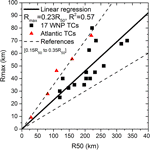Research article
| Highlight paper
|

11 Mar 2016
Research article |
Highlight paper |

|
11 Mar 2016

Maximum wind radius estimated by the 50 kt radius: improvement of storm surge forecasting over the western North Pacific
Hiroshi Takagi and Wenjie Wu
Even though the maximum wind radius (Rmax) is an important parameter in determining the intensity and size of tropical cyclones, it has been overlooked in previous storm surge studies. This study reviews the existing estimation methods for Rmax based on central pressure or maximum wind speed. These over- or underestimate Rmax because of substantial variations in the data, although an average radius can be estimated with moderate accuracy. As an alternative, we propose an Rmax estimation method based on the radius of the 50 kt wind (R50). Data obtained by a meteorological station network in the Japanese archipelago during the passage of strong typhoons, together with the JMA typhoon best track data for 1990–2013, enabled us to derive the following simple equation, Rmax = 0.23 R50. Application to a recent strong typhoon, the 2015 Typhoon Goni, confirms that the equation provides a good estimation of Rmax, particularly when the central pressure became considerably low. Although this new method substantially improves the estimation of Rmax compared to the existing models, estimation errors are unavoidable because of fundamental uncertainties regarding the typhoon's structure or insufficient number of available typhoon data. In fact, a numerical simulation for the 2013 Typhoon Haiyan as well as 2015 Typhoon Goni demonstrates a substantial difference in the storm surge height for different Rmax. Therefore, the variability of Rmax should be taken into account in storm surge simulations (e.g., Rmax = 0.15 R50–0.35 R50), independently of the model used, to minimize the risk of over- or underestimating storm surges. The proposed method is expected to increase the predictability of major storm surges and to contribute to disaster risk management, particularly in the western North Pacific, including countries such as Japan, China, Taiwan, the Philippines, and Vietnam.
Received: 08 Sep 2015 – Discussion started: 27 Oct 2015 – Revised: 18 Feb 2016 – Accepted: 24 Feb 2016 – Published: 11 Mar 2016
